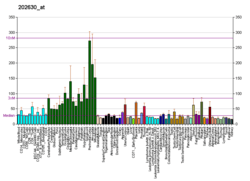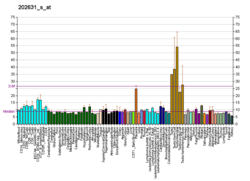APPBP2
| APPBP2 | |||||||||||||||||||||||||
|---|---|---|---|---|---|---|---|---|---|---|---|---|---|---|---|---|---|---|---|---|---|---|---|---|---|
| Identifiers | |||||||||||||||||||||||||
| Aliases | APPBP2, APP-BP2, HS.84084, PAT1, amyloid beta precursor protein binding protein 2 | ||||||||||||||||||||||||
| External IDs | MGI: 1914134 HomoloGene: 31378 GeneCards: APPBP2 | ||||||||||||||||||||||||
| |||||||||||||||||||||||||
| |||||||||||||||||||||||||
| |||||||||||||||||||||||||
| |||||||||||||||||||||||||
| Orthologs | |||||||||||||||||||||||||
| Species | Human | Mouse | |||||||||||||||||||||||
| Entrez | |||||||||||||||||||||||||
| Ensembl | |||||||||||||||||||||||||
| UniProt | |||||||||||||||||||||||||
| RefSeq (mRNA) | |||||||||||||||||||||||||
| RefSeq (protein) | |||||||||||||||||||||||||
| Location (UCSC) | Chr 17: 60.44 – 60.53 Mb | Chr 11: 85.19 – 85.24 Mb | |||||||||||||||||||||||
| PubMed search | [3] | [4] | |||||||||||||||||||||||
| Wikidata | |||||||||||||||||||||||||
| |||||||||||||||||||||||||
Amyloid protein-binding protein 2 is a protein that in humans is encoded by the APPBP2 gene.[5][6]
The protein encoded by this gene interacts with microtubules and is functionally associated with beta-amyloid precursor protein transport and/or processing. The beta-amyloid precursor protein is a cell surface protein with signal-transducing properties, and it is thought to play a role in the pathogenesis of Alzheimer's disease. This gene has been found to be highly expressed in breast cancer. Multiple polyadenylation sites have been found for this gene.[6]
Interactions
APPBP2 has been shown to interact with Amyloid precursor protein.[5]{
References
- 1 2 3 GRCh38: Ensembl release 89: ENSG00000062725 - Ensembl, May 2017
- 1 2 3 GRCm38: Ensembl release 89: ENSMUSG00000018481 - Ensembl, May 2017
- ↑ "Human PubMed Reference:".
- ↑ "Mouse PubMed Reference:".
- 1 2 Zheng P, Eastman J, Vande Pol S, Pimplikar SW (Jan 1999). "PAT1, a microtubule-interacting protein, recognizes the basolateral sorting signal of amyloid precursor protein". Proc Natl Acad Sci U S A. 95 (25): 14745–50. doi:10.1073/pnas.95.25.14745. PMC 24520. PMID 9843960.
- 1 2 "Entrez Gene: APPBP2 amyloid beta precursor protein (cytoplasmic tail) binding protein 2".
External links
- Human APPBP2 genome location and APPBP2 gene details page in the UCSC Genome Browser.
Further reading
- Nagase T, Seki N, Ishikawa K, et al. (1997). "Prediction of the coding sequences of unidentified human genes. VI. The coding sequences of 80 new genes (KIAA0201-KIAA0280) deduced by analysis of cDNA clones from cell line KG-1 and brain". DNA Res. 3 (5): 321–9, 341–54. doi:10.1093/dnares/3.5.321. PMID 9039502.
- Bärlund M, Monni O, Kononen J, et al. (2000). "Multiple genes at 17q23 undergo amplification and overexpression in breast cancer". Cancer Res. 60 (19): 5340–4. PMID 11034067.
- Monni O, Barlund M, Mousses S, et al. (2001). "Comprehensive copy number and gene expression profiling of the 17q23 amplicon in human breast cancer". Proc. Natl. Acad. Sci. U.S.A. 98 (10): 5711–6. doi:10.1073/pnas.091582298. PMC 33278. PMID 11331760.
- Gao Y, Pimplikar SW (2002). "The gamma -secretase-cleaved C-terminal fragment of amyloid precursor protein mediates signaling to the nucleus". Proc. Natl. Acad. Sci. U.S.A. 98 (26): 14979–84. doi:10.1073/pnas.261463298. PMC 64969. PMID 11742091.
- Strausberg RL, Feingold EA, Grouse LH, et al. (2003). "Generation and initial analysis of more than 15,000 full-length human and mouse cDNA sequences". Proc. Natl. Acad. Sci. U.S.A. 99 (26): 16899–903. doi:10.1073/pnas.242603899. PMC 139241. PMID 12477932.
- Benboudjema L, Mulvey M, Gao Y, et al. (2003). "Association of the herpes simplex virus type 1 Us11 gene product with the cellular kinesin light-chain-related protein PAT1 results in the redistribution of both polypeptides". J. Virol. 77 (17): 9192–203. doi:10.1128/JVI.77.17.9192-9203.2003. PMC 187382. PMID 12915535.
- Gerhard DS, Wagner L, Feingold EA, et al. (2004). "The status, quality, and expansion of the NIH full-length cDNA project: the Mammalian Gene Collection (MGC)". Genome Res. 14 (10B): 2121–7. doi:10.1101/gr.2596504. PMC 528928. PMID 15489334.
- Rual JF, Venkatesan K, Hao T, et al. (2005). "Towards a proteome-scale map of the human protein-protein interaction network". Nature. 437 (7062): 1173–8. doi:10.1038/nature04209. PMID 16189514.
This article is issued from
Wikipedia.
The text is licensed under Creative Commons - Attribution - Sharealike.
Additional terms may apply for the media files.





